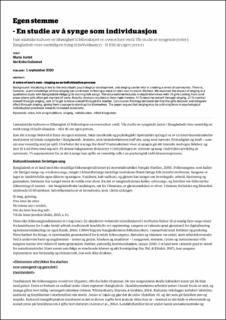| dc.contributor.author | Jordet, Maria | |
| dc.contributor.author | Gullestad, Siri Erika | |
| dc.date.accessioned | 2021-03-19T09:40:20Z | |
| dc.date.available | 2021-03-19T09:40:20Z | |
| dc.date.created | 2020-09-04T14:24:48Z | |
| dc.date.issued | 2020 | |
| dc.identifier.citation | Tidsskrift for Norsk Psykologforening. 2020, 57 (9), 646-656. | en_US |
| dc.identifier.issn | 0332-6470 | |
| dc.identifier.uri | https://hdl.handle.net/11250/2734397 | |
| dc.description | Opprinnelig publisert her: https://psykologtidsskriftet.no/vitenskapelig-artikkel/2020/09/egen-stemme. Publisert i Brage med skriftlig tillatelse fra tidsskriftet. | en_US |
| dc.description.abstract | Background: Vocalizing is key to the individual’s psychological development, and singing can be vital in creating a sense of community. There is, however, scant knowledge on how singing can contribute to inding a voice of one’s own in youth. Method: We explored the impact of singing in a qualitative study with Bangladeshi village girls learning folk songs. The data material includes in-depth interviews with 10 girls coming from rural areas where girls often get married off early. Results: Analysis resulted in three main themes: 1) To become oneself through singing, 2) To comfort oneself through singing, and 3) To get to know oneself through the teacher. Conclusion: Findings demonstrate that the girls discover and integrate affect through singing, giving them courage to stand up for themselves. The paper argues that singing may be a driving force in psychological individuation processes towards increased autonomy. | en_US |
| dc.language.iso | nob | en_US |
| dc.subject | Stemme | en_US |
| dc.subject | Voice work | en_US |
| dc.subject | Affekt-teori, affektintegrasjon, affektbevissthet | en_US |
| dc.subject | Affect theory, afefect integration, affect consciousness | en_US |
| dc.subject | Sang | en_US |
| dc.subject | Song | en_US |
| dc.subject | Folkesanger | en_US |
| dc.subject | Folk songs | en_US |
| dc.title | Egen stemme - en studie av å synge som individuasjon | en_US |
| dc.title.alternative | A voice of one’s own – singing as an individuation process | en_US |
| dc.type | Peer reviewed | en_US |
| dc.type | Journal article | en_US |
| dc.description.version | publishedVersion | en_US |
| dc.source.pagenumber | 646-656 | en_US |
| dc.source.volume | 57 | en_US |
| dc.source.journal | Tidsskrift for Norsk Psykologforening | en_US |
| dc.source.issue | 9 | en_US |
| dc.identifier.cristin | 1827399 | |
| dc.relation.project | Norges forskningsråd: 271560 | en_US |
| cristin.ispublished | true | |
| cristin.fulltext | original | |
| cristin.qualitycode | 1 | |
